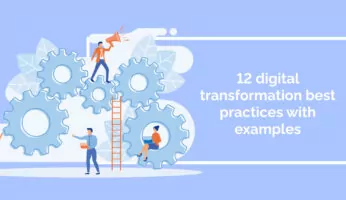
An efficient Workday® implementation shortens your time-to-ROI, accelerates employee productivity, and ensures that the workforce can focus on actually using the software instead of learning to use it.
The success of the implementation can also impact the overall ROI of your investment. A poor implementation, for instance, can decrease the overall utilization of the software, employee engagement, employee productivity, and, as a result, software ROI.
Below, we will look at a few steps you can take to improve your Workday® implementation.
How to Simplify and Accelerate Your Workday® Implementation
One of the most important things to keep in mind is that the successful implementation of complex software requires careful planning.
Adopting a new enterprise platform across the organization, after all, is not the same as deploying a new software on an individual computer.
When deploying any new software program is important to:
- Create goals, such as maximizing software ROI, employee productivity, and achieving specific objectives within certain timeframes
- Identify challenges to implementation, which can include a lack of digital skills, resistance from employees, technical challenges, and poor communication
- Develop a plan for both achieving goals and overcoming challenges
Taking a structured approach to Workday® adoption can achieve many of the benefits named earlier – namely, you can both shorten the time it takes to start earning ROI on your investment and raise the overall return on your investment.
Let’s look at some of the steps you must take to ensure the effective adoption of Workday®, or any other sophisticated enterprise platform.
Designing a digital adoption strategy for Workday®
To successfully adopt digital software, we need to clarify what distinguishes an unsuccessful digital adoption effort versus a successful one.
Successfully implementing enterprise tools depends on factors such as:
- Digital skills
- How well the platform integrates with other enterprise tools
- Executive support
- Cooperation from IT
Accounting for factors such as these, which can become challenges if left unaddressed, can improve your chances of successful adoption, minimize resistance, and help your organization accelerate its digital change programs.
This brings up the first point to address when creating a digital adoption strategy.
Identify your top priorities and challenges
Create a set of goals that will act as your north star. This overarching set of goals will be the driving force behind your adoption strategy.
It can even help to articulate this with a strategic statement, a concise statement that encapsulates the primary goal of the digital adoption strategy.
Once these goals have been created, you can turn them into measurable objectives, key performance indicators, an individual metrics.
At the same time, gap analyses, business impact analyses, assessments, and similar tools can help you identify the challenges you will face when pursuing those goals.
Road map the adoption process
In general, digital adoption processes – including Workday® implementations – include the same stages:
- Onboarding
- Training
- Ongoing support
Additionally, there are several dimensions to pay attention to during adoption:
- Organizational change planning
- Technical deployment
- The workforce
Employees, for instance, not only need the technical skills to use software, they also need the right mindset, which will affect their motivation, morale, attitudes, and, as a result, engagement.
Map your priorities to the adoption process
Each of the stages mentioned above should have its own set of goals, metrics, roles, and responsibilities.
A digital adoption manager, for instance, would be responsible for architecting the adoption process, interacting with stakeholders, assisting with training. Design, and otherwise supporting the adoption process.
Change managers, on the other hand, would focus more on the human side of change, such as reducing employee resistance and improving communication.
Execute the process
Implement carefully, manage continuously, and make adjustments as needed. To do this, data should be collected in real-time.
Process mining is a good way to analyze your Workday® implementation as it progresses, as well as its ongoing performance after the implementation is complete.
Task mining is similar to process mining, except that it focuses on frontend workflows. Using tools such as WalkMe’s digital adoption platform, you can track employees interactions with the software program. This information, in turn, can be used to gain insight into where employees need training, as well as the efficiency of business processes.
Also, data-driven methods should be combined with an agile approach to change management.
During any change, especially those that have a dramatic impact on the workplace, employee resistance, change, fatigue, or software-related frustration can be a problem. Staying agile can help you deal with these unexpected challenges.
Final Thoughts
Agile methods, as mentioned, are ideal for handling the uncertainty that comes with change and the unknown obstacles that you will face during Workday® implementations.
Yet not all obstacles are unforeseen.
Many, in fact, are predictable.Using a digital adoption platform such as WalkMe, however, can help you overcome the most common challenges, such as the digital skills gap, data migration challenges, existing HR practices, software-related frustration, and employee resistance.
WalkMe Team
WalkMe spearheaded the Digital Adoption Platform (DAP) for associations to use the maximum capacity of their advanced resources. Utilizing man-made consciousness, AI, and context-oriented direction, WalkMe adds a powerful UI layer to raise the computerized proficiency, everything being equal.



